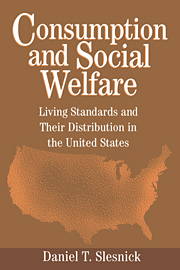Book contents
- Frontmatter
- Contents
- Acknowledgments
- 1 Introduction
- 2 The measurement of economic welfare
- 3 Measuring consumption: An initial look at the data
- 4 The cost of living
- 5 The standard of living
- 6 Does a rising tide raise all ships?
- 7 Consumption and poverty
- 8 Conclusions
- Appendix 1 Measuring individual and social welfare
- Appendix 2 Interpolating and extrapolating the expenditure distribution
- References
- Index
Appendix 2 - Interpolating and extrapolating the expenditure distribution
Published online by Cambridge University Press: 10 December 2009
- Frontmatter
- Contents
- Acknowledgments
- 1 Introduction
- 2 The measurement of economic welfare
- 3 Measuring consumption: An initial look at the data
- 4 The cost of living
- 5 The standard of living
- 6 Does a rising tide raise all ships?
- 7 Consumption and poverty
- 8 Conclusions
- Appendix 1 Measuring individual and social welfare
- Appendix 2 Interpolating and extrapolating the expenditure distribution
- References
- Index
Summary
The Consumer Expenditure Surveys are the only sources of disaggregated expenditure data in the United States. These surveys were administered approximately every ten years until 1980, at which time they were given annually. To obtain estimates of the standard of living, inequality, and the extent of poverty in the years in which surveys were not administered, the simplest and most common approach is to linearly interpolate each summary statistic between survey years. This approach does not exploit all of the information available, and, moreover, there is no guarantee that the resulting estimates will be mutually consistent.
In this appendix, I describe an alternative method of estimating the distribution of total expenditure in the years for which there are no survey data. This covers the years 1947-1959, 1962–1971, and 1974–1979. The fundamental assumption is that total expenditure is lognormally distributed within 1,344 cells cross-classified according to the following characteristics:
Household Size: 1,2,3,4,5,6,7 or more.
Age of Head of the Household: 16–24, 25–34, 35–4, 45–54, 55–64, and 65 and over.
Region of Residence: Northeast, Midwest, South, and West.
Race of Head of the Household: White, Nonwhite.
Type of Residence: Farm, Nonfarm.
Gender of Head of the Household: Male, Female.
The assumption of lognormality greatly simplifies the interpolation of the distribution of total expenditure between survey years. The critical issue is whether the estimated expenditure distribution accurately approximates the empirical distribution.
- Type
- Chapter
- Information
- Consumption and Social WelfareLiving Standards and their Distribution in the United States, pp. 209 - 214Publisher: Cambridge University PressPrint publication year: 2000



